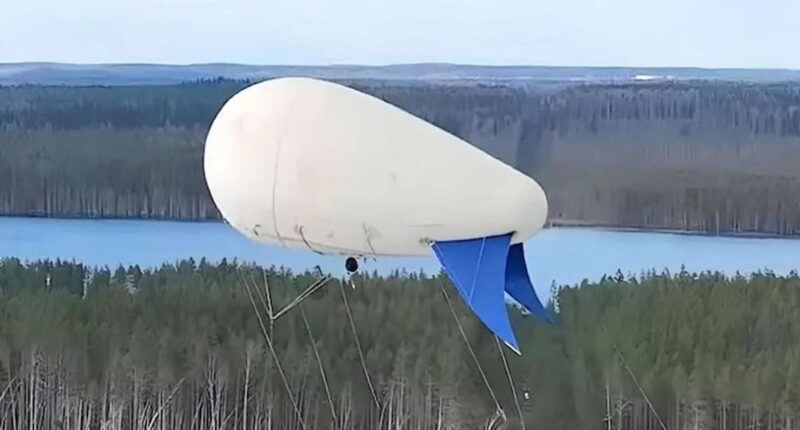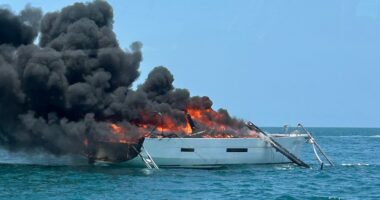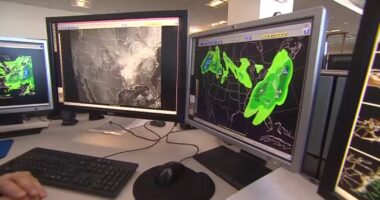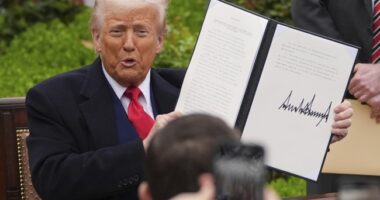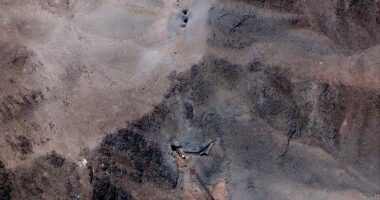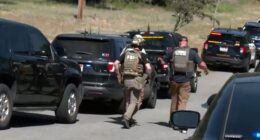Russia has positioned mysterious blimps on NATO’s borders, sparking fears they could be part of a new spying operation or prelude to attack.
A strange aircraft that resembled a white spaceship was spotted near Narva, Estonia’s third largest city, on the Russian side of the border, close to NATO territory in June. The unusual sighting left many perplexed.
Estonian authorities initially decided to ignore the suspicious blimp, but the following day alarm bells began ringing when it returned – this time marked with a ‘Z’, the symbol of Putin’s brutal invasion of Ukraine.
The incident sowed fear and confusion for Estonia, with the director-general of the border force in the northern European country explaining: ‘We are seeing things like this nearly every week’.
He also highlighted that although it ‘good to see that Russia is using modern technology’ through the mysterious blimps, ‘it was intentionally made visible to everyone, to say: ‘We are watching you’.
‘They’re trying to provoke a reaction. They want to see how we respond,’ Belitsev said.
The sightings of the blimps are also raising concerns among locals in the Estonian capital who fear it may be a chilling prelude to a Russian attack.
One woman told the Telegraph: ‘We are constantly thinking about it, our prime minister has said if Ukraine wins we are safe and if not we are in deep trouble, that’s a creepy thought’.

The white spaceship-like aircraft was seen in June on the Russian side of the frontier near Narva, Estonia’s third largest city, on the far outskirts of NATO territory

Estonian authorities initially decided to ignore the suspicious blimp, but the following day alarm bells began ringing when it returned – this time marked with a ‘Z’, the symbol of Putin ‘s brutal invasion of Ukraine
Located on NATO’S eastern border, Narva has become the constant target of warfare tactics employed by Russia – with the Kremlin having regularly dropped these surveillance blimps and removing Estonian border infrastructure in the middle of the night.
Tensions on Narva’s 200-mile frontier have sky-rocketed in recent months, according to Estonian border guards.
Police have claimed there has been a rise in numbers of border security incidents, such a anti-West protests, attempted smuggling of weapons parts, and dangerous aircraft stunts.
The Narva Museum – which faces directly towards Russia – has also found itself at the centre of the growing tensions after conducting a number of anti-Putin stunts and hosting exhibitions that highlight Russian propaganda and war crimes.
For the last two years, the museum has displayed a banner reading ‘Putin is a war criminal’ on the side of Narva’s castle, facing towards Ivangorod, a Russian border town that lies just 101 metres away.
Russian officials demanded that Estonian border representatives take the anti-Putin banner down, but they refused.
Estonia, which joined NATO and the EU in 2004, defiantly remains one of Russia’s most vocal opponents in Europe.
Following Russia’s invasion of Ukraine in February 2022, Estonia forked out more money towards military aid for the war-torn country than any other, and it proudly supports Kyiv’s ambitions to join NATO.
This support, and Estonia’s decision to implement restrictions at the Narva crossing point used by the city’s Russian speakers has infuriated Putin, who at the time of his invasion of Ukraine, indicated that he had his sights set on Narva, suggesting that it would be justifiable to ‘take back and secure’ the border city.

Estonia’s support of Ukraine has infuriated Putin

A Swedish artillery team fires a projectile from an Archer self-propelled Howitzer during the NATO ‘Exercise Lightning Strike’ on November 20

The live-fire exercise includes service members from 28 Allied and partner nations, and took place between November 4-24, across locations in Finland, Estonia, Germany, Poland, and Romania

Some 96 per cent of the 56,000 people living in Narva speak Russian as their first language, while 34 per cent of the population are Russian citizens.
Belitsev said two years ago Estonia had 18 border incidents and this year they had 96
In May, Russian border guards were also accused of stealing 20 buoys from the Narva river in the dead of night in what was seen as an attempt to reestablish the edges of Russian territory.
Belitsev slammed the 3am move, saying: ‘This is not something you do if it is a proper or normal thing’.
On top of this, Russia is accused to purposely slowing down border checks ahead of an Estonian national parade in an attempt to flood the local area with queues.
Almost six months on, people still find themselves queuing for more than 12 hours in the snow to cross into Russia.
Estonia’s border force has pointed the finger of blame at the Kremlin, but within Narva, some blame is being targeted at the Estonian government.
Russia has closed off the Narva checkpoint to all vehicles, so the only way through is on foot.
Russians can use the crossing to enter Estonia, but only if they meet certain strict criteria, such as visiting close relatives.

Prime Minister of Sweden Ulf Kristersson and UK Prime Minister Sir Keir Starmer shake hands prior to bilateral talks at Knighthood House on December 17, 2024 in Tallinn, Estonia. Starmer is paying official visits to NATO member countries Norway and Estonia this week

The two-week international military exercise Pikne – translating to lightning – began in Estonia on December 2

Estonia, which joined NATO and the EU in 2004, defiantly remains one of Russia’s most vocal opponents in Europe
‘If you want to go into the Russian federation, it shouldn’t be comfortable. Russia is an aggressor country that has conducted extensive military action for more than 1,000 days in one of their neighbouring countries,’ Belitsev said.
‘Anybody with a clear sense of mind wouldn’t go there.’
In Estonia’s capital, Tallinn, this week, Nordic and Baltic leaders gathered for the annual summit of the Joint Expeditionary Force, a UK-led rapid response force that complements Nato troops in the region.
Erkki Tori, a senior Estonian government adviser, said there were no signs that Russian aggression against Ukraine and the rest of Europe would reduce next year.
‘Russia will remain a threat for a very significant time, we don’t see any changes in the mindset of the Russian regime,’ Tori warned.
‘Russia’s understanding is that we will become more tired and they can outlast us in this war of aggression. Russia sees itself as being at war with NATO and therefore the ends justify the means.’
It comes just weeks after Estonia launched large-scale NATO exercises near its border with Russia.
The two-week international military exercise Pikne – translating to lightning – began in Estonia on December 2.
‘We are putting the synergy and cooperation to test across different countries, branches of service and units,’ said Colonel Janno Mark, Chief of Staff of the Estonian division.
The main exercises took place from December 2 to December 15, mainly in the north and northeast of Estonia for the ground and air forces.
